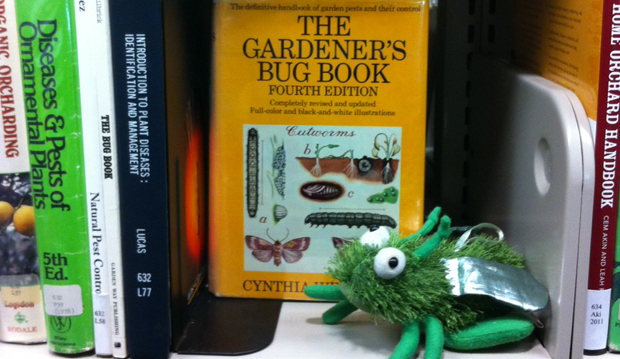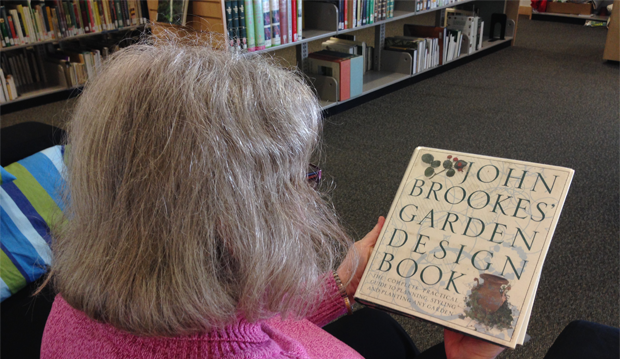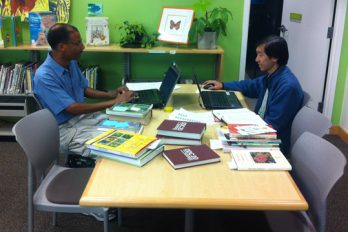“… have you ever wondered how insects and plants relate to one another? In some ways they are partners; in other ways they are enemies.” D.H. Patent, Plants and Insects Together, 1976.
One of the most popular reference questions we receive at the Weston Family Library has to do with identifying, treating and preventing pests and diseases in the garden. These problems can leave even the novice gardener stumped.
Reliable information is hard to find, so we’ve helped to make it a bit easier. Here are some of the library’s most helpful resource books describing plant pests and diseases, and how to control them. Annotations are provided by Weston Family Library volunteer and Master Gardener, Jean Gardiner.
Plant Problems: Prevention and Control by Stefan Buczacki, Devon & Charles: 2000.
Call number: 632 B78 (Main collection)
This authoritative and practical reference book is written by a gardener and scientist. Part one tells how plants work; what they need to survive, when they are at their most vulnerable; and provides numerous gardening tips to help eradicate problems. Part two describes how to conquer existing problems with a variety of organic methods − feeding, relocating, mulching, methods of protection, as well as the traditional approach of fungicides and pesticides. A quick reference section offers instant plant and problem identification. Well illustrated with coloured photographs, this is a book for those who are curious about the principles of plant physiology. Overall, Plant Problems is a fascinating read.
What’s Wrong with My Plant? Expert Information at Your Fingertips by Steven Bradley London: Octopus Books, 2003.
Call number: 632 B66 (Main collection)
Accurate identification is the key to success in dealing with plant pests and diseases. Descriptions of plant pests, diseases and disorders as well as chemical, organic and biological treatments are well illustrated with full colour photographs. The ten most common plant pests, diseases and disorders plus specific problems of leaves, flowers, fruits, stems, roots, the whole plant, seeds and seedlings are followed by checklists and troubleshooting identification tips.
The Organic Gardener’s Handbook of Natural Insect and Disease Control: A Complete Problem-solving Guide to Keeping Your Garden and Yard Healthy Without Chemicals by Barbara W. Ellis and Fern Marshall Bradley, editors, Emmaus, PA: Rodale Press, 1992.
Call number: 632 O68 (Main collection)
More than 200 vegetables, fruits, herbs, flowers, trees and shrubs are covered in this easy-to-use problem-solving encyclopedia. It contains complete directions on how, when and where to use preventive methods, insect traps and barriers, biocontrols, homemade remedies, botanical insecticides and more. Over 360 colour photographs provide quick identification of insect pests, beneficial insects and plant diseases.
Natural Insect Control: The Ecological Gardener’s Guide to Foiling Pests by Warren Schultz, Brooklyn, NY: Brooklyn Botanic Garden, 1994.
Call number: 632 N13 (Main collection)
This encyclopedia of pests includes a description of each insect and the various forms in its life cycle and is well illustrated with large full-colour drawings. Natural controls only are covered, including growing tips, row covers and other physical controls, natural predators and natural pesticides.
Field Guide to Tree Diseases of Ontario by C. N. Davis and T. R. Meyer, Sault Ste. Marie, ON: Natural Resources Canada, 2004.
Call number: 632 D136 (Main collection)
Intended for use in the field to identify approximately 150 tree diseases, this guide is designed to assist in assessing pest problems and their potential damage. Causal agents of tree diseases are grouped into: rusts, decays, wilts, cankers, needle casts and anthracnose/leaf spots. Diseases are listed as: of Leaves and Needles; Stems and Branches; Roots; Cones; and Damage caused by Abiotic Agents. Each disease has an accompanying page of full-colour photographs of the damage.
Happy reading, and may your plants be pest- and disease-free!
Zachary Osborne, Head Librarian




